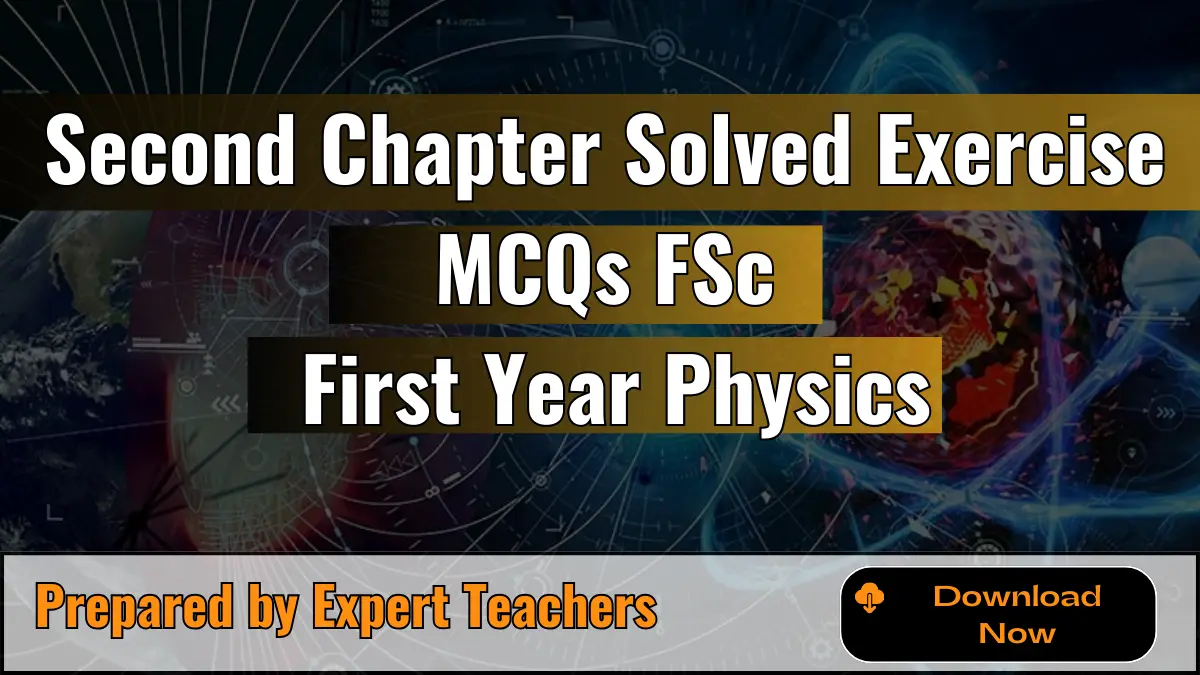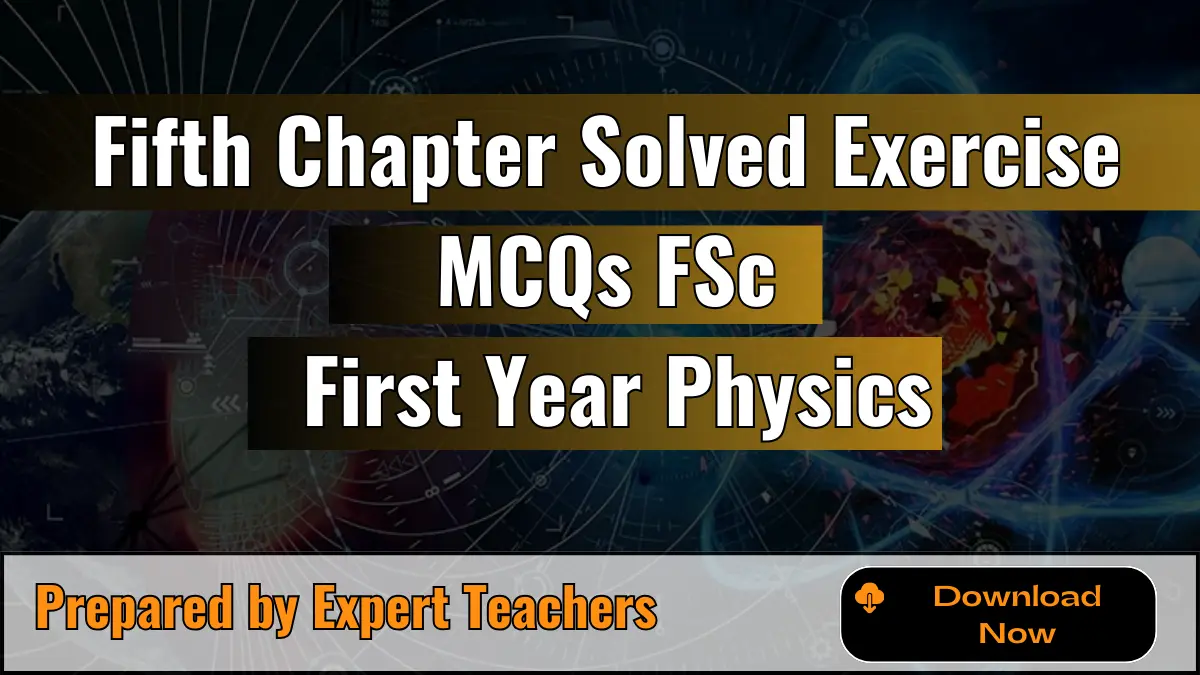Third Chapter Solved Exercise MCQs Of FSc First Year Physics
Third Chapter Solved Exercise MCQs of FSc First Year Physics are helpful for FSc students. It includes multiple-choice questions from the first chapter, each with a clear answer and explanation. This resource is perfect for reviewing key ideas, practicing for exams, and improving your understanding of physics concepts.
Third chapter solved MCQs with explanation
- Which of the following can be zero if a body is in motion for some time?
(a) Speed
(b) Displacement
(c) Distance covered
(d) None
Explanation: Option (b) is Correct. Displacement is a vector quantity that depends on both the magnitude and direction of the motion. Even if a body moves a certain distance, its displacement can be zero if it returns to its starting point. Therefore, a body can be in motion for some time and yet have zero displacement.
2. If the displacement covered by a body is zero, then what can you say about its distance?
(a) It is negative
(b) It may and may not be zero
(c) It must be zero
(d) It cannot be zero
Explanation: Option (b) is Correct. Distance is a scalar quantity that only depends on the magnitude of the motion. If a body returns to its starting point, its displacement is zero, but its distance traveled is not. Therefore, the distance covered by a body can be zero or non-zero if its displacement is zero.
3. The slope of the velocity time graph for retarded motion is:
(a) Zero
(b) Positive
(c) Negative
(d) Neutral
Explanation: Option (c) is Correct. In retarded motion, the velocity of the body decreases over time. This means that the slope of the velocity-time graph, which represents the acceleration, is negative.
4. Two bodies are moving in opposite directions with velocity v. What is the relative velocity between them?
(a) 2v
(b) 2v
(c) v
(d) Zero
Explanation: Option (d) is Correct. Relative velocity is the velocity of one object as seen from another object. If two bodies are moving in opposite directions with the same velocity, their relative velocity with respect to each other is zero. This is because they are moving at the same rate and in the same direction relative to each other.
5. Area under velocity time graph represents.
(a) Force
(b) Displacement
(c) Distance
(d) Acceleration
Explanation: Option (b) is Correct. The area under a velocity-time graph represents the displacement of the body. This is because the velocity multiplied by time gives distance, and the area under the graph is essentially the sum of the small distances traveled over time.
6. Instantaneous and average velocities become equal if a body has
(a) Zero acceleration
(b) Uniform acceleration
(c) Variable acceleration
(d) Moves in a circle
Explanation: Option (a) is Correct. When a body has zero acceleration, its velocity remains constant. In this case, the instantaneous velocity (velocity at a particular instant) and the average velocity (total displacement divided by total time) will be the same.
7. Inertia of an object is measured by its
(a) Volume
(b) Density
(c) Mass
(d) Temperature
Explanation: Option (c) is Correct. Inertia is the resistance of an object to change its state of motion. It depends on the mass of the object. A more massive object has more inertia and therefore requires a greater force to accelerate or decelerate.
8. 2nd law of motion defines
(a) Inertia
(b) Acceleration
(c) Velocity
(d) Both a and b
Explanation: Option (b) is Correct. Newton’s second law of motion states that the acceleration of an object is directly proportional to the net force acting on it and inversely proportional to its mass. This law defines the relationship between force, mass, and acceleration.
9. When a body moves in a straight line then its displacement coincides with
(a) Distance
(b) Force
(c) Velocity
(d) None
Explanation: Option (d) is Correct. Displacement is a vector quantity that depends on both the magnitude and direction of the motion. Distance is a scalar quantity that only depends on the magnitude of the motion. When a body moves in a straight line without changing its direction, its displacement is equal to its distance. However, this is not always the case, especially when the body changes direction.
10. The rate of change in momentum of a body falling freely is equal to its
(a) K.E.
(b) Momentum
(c) Power
(d) Weight
Explanation: Option (d) is Correct. The rate of change of momentum is equal to the net force acting on the body. For a body falling freely, the net force acting on it is its weight. Therefore, the rate of change in momentum of a body falling freely is equal to its weight.
11. A small sports car collides head-on with a massive truck. Which vehicle experiences the greater impact force (in magnitude)?
(a) The car
(b) The truck
(c) They experience the same force
(d) None of these
Explanation: Option (c) is Correct. According to Newton’s third law of motion, for every action, there is an equal and opposite reaction. This means that the force exerted by the car on the truck is equal in magnitude to the force exerted by the truck on the car. Therefore, both vehicles experience the same impact force.
12. In the above question, which vehicle experiences the greater acceleration?
(a) The car
(b) The truck
(c) They experience the same acceleration
(d) None of these
Explanation: Option (c) is Correct. According to Newton’s second law of motion, the acceleration of an object is directly proportional to the net force acting on it and inversely proportional to its mass. Since both vehicles experience the same impact force, the vehicle with the smaller mass will experience the greater acceleration. In this case, the small sports car will experience a greater acceleration than the massive truck.
13. A baseball of mass m is thrown upward with some initial speed. If air resistance is neglected, the force acting on the ball when it reaches its peak is:
(a) mg and upward
(b) mg and downward
(c) Zero
(d) None of these
Explanation: Option (b) is Correct. At the peak, the ball momentarily stops before falling back down. However, the force of gravity continues to act on it, pulling it downward.
14. A body is moving in a straight line such that the distance covered by it in time t is proportional to the square of the time t. The acceleration of the body is:
(a) Constant
(b) Zero
(c) Increasing
(d) Decreasing
Explanation: Option (a) is Correct. If the distance is proportional to the square of time, the body’s motion is uniformly accelerated.
15. SI unit of impulse is equivalent to:
(a) Force
(b) Momentum
(c) Acceleration
(d) None
Explanation: Option (b) is Correct. Impulse is the product of force and time, which is equivalent to the change in momentum.
16. Taking off of a rocket can be explained by:
(a) 1st law of motion
(b) 2nd law of motion
(c) 3rd law of motion
(d) None
Explanation: The Correct answer is (b). The rocket’s acceleration is due to the force exerted by the expelled gases, explained by Newton’s second law.
17. Which component of acceleration is zero in projectile motion?
(a) Horizontal
(b) Vertical
(c) Both
(d) None
Explanation: The Correct answer is (d). In projectile motion, the only force acting on the object is gravity, which causes a constant vertical acceleration. The horizontal component of velocity remains constant.
18. A fighter plane drops a bomb when it is at the top of enemies’ target. Bomb misses the target due to:
(a) Due to bad weather
(b) Due to action of gravity
(c) Due to horizontal component of velocity
(d) All of above
Explanation: Option (c) is Correct. The bomb’s horizontal velocity causes it to travel forward while gravity pulls it downward, leading to a parabolic path that misses the target.
19. A ball is thrown horizontally from the top of a tower. What happens to the horizontal component of its velocity?
(a) First increased then decrease
(b) Increases
(c) Remains same
(d) None of these
Explanation: Option (c) is Correct. In the absence of air resistance, the horizontal component of velocity remains constant.
20. What is the angle of projection, so that the horizontal range is equal to maximum height?
(a) Tan⁻¹ (4)
(b) Tan⁻¹ (3)
(c) Tan⁻¹(2)
(d) Tan⁻¹(1)
Explanation: Option (c) is Correct. When the horizontal range equals the maximum height, the angle of projection is 75.96 degrees (approximately), which corresponds to Tan⁻¹(2).







Leave a Reply